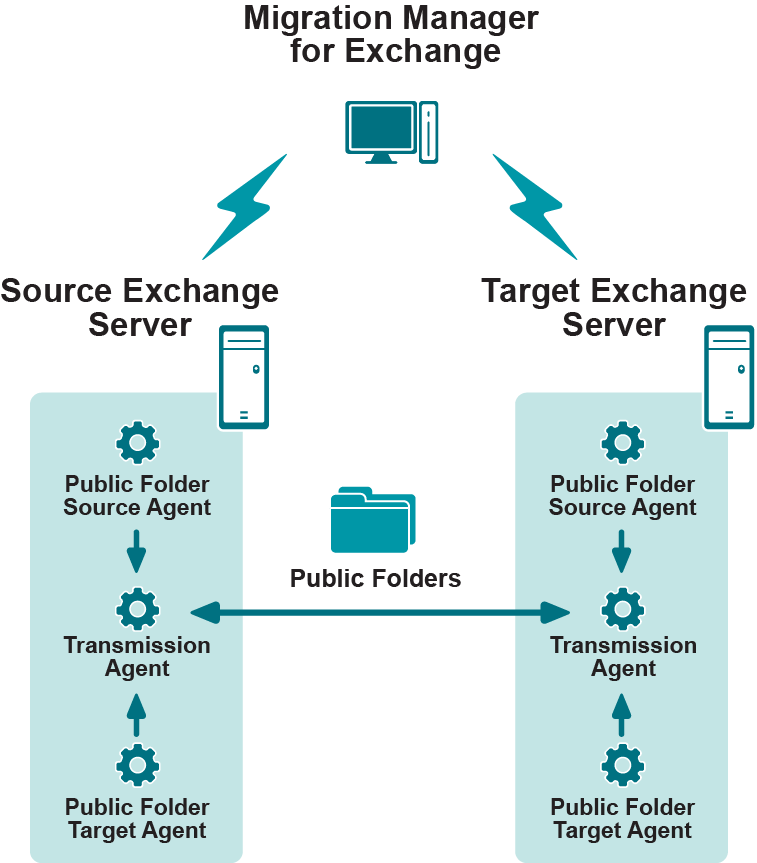Public Folder Synchronization Process
Before the users are migrated to the new environment, you need to copy the contents of the public folders to the new servers. This will ensure that the first migrated user will access up-to-date public folder information.
Migration Manager for Exchange can synchronize public folders in two directions. When a user that is already migrated to the target environment posts a note to a target public folder, the note automatically gets posted to the corresponding source public folder. This lets the users share data throughout the migration process.
Client permissions on public folders are also preserved and synchronized in both environments. Source public folder permissions are automatically translated into the corresponding target public folder permissions.
Migration Manager for Exchange also allows you to reconfigure the structure of your public folders on the fly. You can use this ability to improve the public folder structure in the source and target environments.
Public Folder Synchronization Job
Public folder synchronization is performed by public folder synchronization jobs. It is sufficient to set up one job between each pair of Exchange servers on which public folders to be synchronized are hosted.

Because Migration Manager for Exchange can synchronize public folders in both directions, each server can be both a source and target for data at the same time. Accordingly, if two-way public folder synchronization is selected, install the source and target public folder agents and the transmission agent on each server involved in public folder synchronization.
For one-way synchronization, install the Public Folder Source Agent and the Transmission Agent on the source server, and install the Public Folder Target Agent on the target server. These agents are described in further detail below.
Public Folder Collections
Migration Manager allows you to fine-tune the public folder synchronization job using public folder collections.
A collection is a set of pairs of the source and target folders that will be used as roots of synchronization. Each collection can include several synchronization roots.
A job can handle multiple collections, and each of these collections has its own settings and priority. However, normally you do not need to set up more than one public folder collection. You can easily exclude a public folder from the collection when you set up a public folder synchronization job or by using the public folder collection's Properties dialog box.
Public Folder Synchronization Agents
The following public folder synchronization agents are installed on the Exchange servers:
Public Folder Source Agent
The Public Folder Source Agent iterates through the folders of the currently processed public folder collection. For each folder under the synchronization root folder, the Public Folder Source Agent queries Exchange for the changes made since the last saved synchronization state. The agent retrieves these changes and puts them into a personal folders (PST) file.
PST files are data files that store your messages and other items on your computer. This file format is used by Microsoft Outlook to store and back up items.
The PST file is compressed and put to a service file (PUB) together with auxiliary information for the target agent.
The Public Folder Source Agent processes the public folder collections in the order of their assigned priorities, starting with the collection having the highest priority.
|

|
NOTE: During two-way public folder synchronization, the Public Folder Source Agent installed on the source server performs all of the above actions for the source server, and the Public Folder Source Agent installed on the target server performs the same actions for the target server, using it as a source of information. |
Transmission Agent
Then the Transmission Agent moves the PUB files created by the Public Folder Source Agent to the target Exchange server. To reduce network load, the agent moves the PUB files with data directly to the destination server.
If public folder data from the server is synchronized with several servers, the Transmission Agent moves data in parallel, using a separate thread for each target server.
Public Folder Target Agent
The Public Folder Target Agent processes the incoming PUB files, decompresses their contents, and puts them into the target public folders.
The public folder synchronization agents do not change anything in the synchronized messages and folders; all the message fields (including the sent and received dates and all address fields) and folder properties remain unchanged. The users in both Exchange organizations see the same messages in their public folders.
|

|
NOTE: During two-way public folder synchronization, the Public Folder Target Agent installed on the target server performs all of the above actions for the target server, and the Public Folder Target Agent installed on the source server performs the same actions for the source server, using it as a target for public folder data migration. |



